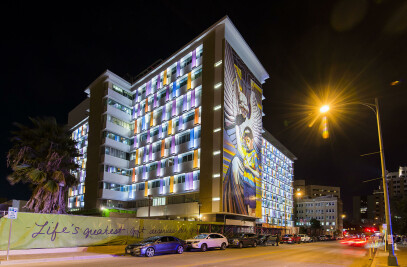The new Liberal Arts Building (CLA) at the University of Texas at Austin is a multifunctional academic building for the largest college on campus with an annual enrollment of over 15,000 students. With departments previously scattered throughout campus, a new building was vital to the ongoing success and reputation of the College.
However, due to a lack of construction funding from customary channels, the College had planned to self-fund the project through program cuts. By evaluating efficiencies and flexibility, the project was implemented in a way that reduced costs and decreased construction time while still using the highest quality building materials. At 68 percent efficiency, the building yielded 20 percent more useable space than programmed, and was delivered $15,000,000 under budget and a semester ahead of schedule.
The building facilitates collaboration through the integration of both formal and informal meeting spaces, strategic circulation that provides opportunities for “collision” between members of various departments, and visual connections between rooms and floors. Leveraging unused space in the adjacent Student Activity Center (SAC), a sky bridge physically connects the CLA to SAC, giving students access to its upper two floors, which house additional program space for the College.
Classrooms are distributed on every floor, and academic offices circumnavigate the entire building so that students and faculty occupy the same space. The building is conceived to have a 100+ year lifespan with administrative and faculty spaces designed to be retrofitted and reorganized as the college’s needs change over time. Perimeter bays are cantilevered to provide floor plan flexibility while reducing columns and piers. Glazed demountable partitions located throughout these areas transmit daylight to interior spaces and can also be reconfigured.
Through the use of innovative technologies and highly efficient mechanical and electrical systems, the building uses 48% less energy than a baseline code-compliant building. Energy efficiency strategies, among others, include the use of active chilled beam mechanical systems, interior daylighting, and mitigation of solar heat gain. Within the chilled beam system, chilled water from the campus central plant is first used for conventional mechanical systems within the building core.
The warmed chilled water—appropriate for chilled beams—is then circulated through chilled beams located in the perimeter faculty offices, which allows faculty offices to be cooled at no cost while providing individual temperature control. This secondary use of chilled water raises the temperature to the optimum level for return. This strategy uses less chilled water overall, leaving additional capacity at the campus central plant for cooling future buildings.
Exterior insulated glazing units with ceramic fritting allow for solar control. Horizontal exterior sunscreens and interior light shelves with operable roller shades are integrated into this glazing system, controlling daylight and heat gain throughout the day and year-round. Full-height terracotta panels provide vertical solar shading to adjacent glazing as well as to a highly insulated backup wall behind.
The rainscreen allows natural convection between this backup wall and the terracotta assembly, further reducing solar heat gain throughout the day. This combination of high-efficiency glazing, sunscreens, and high R-value exterior walls allow the design to achieve fifty-five percent glazing around the building perimeter while providing an overall envelope that exceeds local building codes.
Faculty offices operate without artificial lighting for the majority of operating hours and additional controlled daylight penetrates into interior occupied zones. A substantial program and tight site required careful consideration for building massing and necessitated a broad, square-shaped footprint. The design incorporates large notches in the building floor plates to allow daylight to penetrate further into the building and afford additional views outside. Stairwells are skylit, creating a luminous core within a broad floor plate.
CLA references historical campus buildings through its tripartite division as well as material and color palettes. The terracotta rainscreen relates to historical terracotta used by other campus buildings, with a color that matches the limestone also found throughout campus. A color palette for the ceramic fritting on adjacent glazing was derived from the colorful glazed soffits found on historical campus buildings.

































